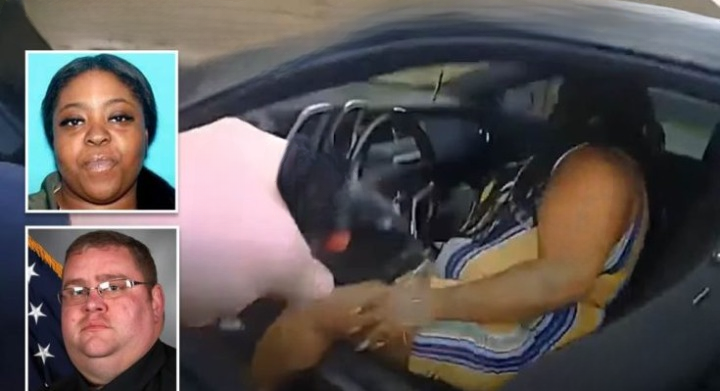
Nashville, Tennessee — What began as a seemingly ordinary traffic stop on a calm Friday morning quickly turned into a violent confrontation, leaving a police officer seriously injured and a 31-year-old woman fatally wounded. Authorities have now released both body camera and dashboard footage of the incident, shedding light on how rapidly routine law enforcement interactions can spiral into life-or-death situations.
The exchange, which unfolded within minutes, has raised pressing questions about policing, community trust, officer training, and how future tragedies might be prevented.
The Traffic Stop
At approximately 9:30 a.m. on a quiet Nashville street, Metro Police Officer Josh Baker initiated a stop on a black Chevrolet Camaro. The vehicle was flagged in police records because its registered owner, 42-year-old Demond Buchanan, had multiple outstanding warrants.
However, when Baker approached the car, it was not Buchanan behind the wheel. Instead, 31-year-old Nika Holbert was driving. The connection between Holbert and Buchanan remains unclear, but her unexpected presence immediately shifted the dynamics of the stop.
Dashcam video shows the officer following standard procedure — introducing himself, calmly explaining the reason for the stop, and requesting Holbert’s driver’s license. Initially, their exchange appeared uneventful. But the situation would soon change.
Escalation Begins
According to body camera footage and subsequent police statements, Baker noticed Holbert growing increasingly nervous. Following established procedure, he asked to search her belongings. Inside her purse, officers reported finding a small bag containing a powdery substance. Although testing would have been required to confirm the contents, the discovery was sufficient for Baker to begin placing Holbert under arrest.
At this point, Holbert’s demeanor shifted. She became visibly upset and pleaded with the officer, repeatedly insisting she had done nothing wrong. “Don’t put me in handcuffs,” she protested, her voice breaking with fear.
Despite Baker’s attempts to remain calm, Holbert resisted. In response, Baker deployed his Taser — a non-lethal tool officers are trained to use when individuals resist arrest but do not pose an immediate deadly threat.
Yet the Taser failed to fully subdue her. Holbert managed to break free and re-enter the driver’s seat of the Camaro.
The Moment of Gunfire
What happened next unfolded in mere seconds. Bodycam footage shows Holbert reaching toward a firearm inside the car. Baker, realizing the danger, gave loud commands for her to drop the weapon.
Within moments, gunfire erupted. Both Baker and Holbert were struck during the exchange.
Baker, a 14-year veteran of the Metro Nashville Police Department, collapsed briefly but managed to call for backup over his radio: “Shots fired… officer down.” His ability to stay composed under immense stress was later praised by colleagues and supervisors, as it allowed emergency responders to reach the scene quickly.
Holbert, though critically wounded, attempted to drive away. Her Camaro made it only about a block before crashing at a nearby intersection. Emergency responders arrived shortly after, rushing her to Skyline Medical Center. Tragically, she was pronounced dead later that day.
Baker was transported to Vanderbilt University Medical Center, where he underwent surgery. Officials later confirmed he was in stable condition and recovering, though the injury was serious.
Official Response
As is standard in officer-involved shootings, the Tennessee Bureau of Investigation (TBI) immediately launched an independent inquiry. The agency will present its findings to the District Attorney’s office to determine whether any additional legal or procedural steps are necessary.
Metro Nashville Police Chief John Drake addressed the public after reviewing the footage. He emphasized that Officer Baker appeared to follow departmental policy, noting that he attempted multiple non-lethal interventions before the incident escalated.
“Officer Baker appeared to do everything he could to try to de-escalate the situation,” Drake said. “Traffic stops can change in an instant, and this incident shows just how dangerous they can become.”
Community Reaction
The release of the footage sparked mixed reactions in Nashville and beyond. Many residents expressed relief that Officer Baker survived his injuries, describing him as a dedicated public servant with years of experience. Others, however, mourned the death of Nika Holbert and questioned whether the outcome could have been avoided.
Holbert’s adoptive mother, Lisa Holbert-Gooch, shared her grief with local reporters. While acknowledging her daughter’s mistake in drawing a firearm, she expressed deep pain over the final outcome. “I know she made a wrong choice, but I can’t help but wonder if there was another way this could have ended,” she said.
Her words reflect the difficult balance between accountability and compassion — a tension that frequently surfaces in cases involving fatal police encounters.
A Broader National Conversation
The Nashville shooting has once again reignited the national conversation around policing, accountability, and community trust. Across the United States, traffic stops are among the most common interactions between law enforcement and citizens. Yet, as many officers and researchers point out, they are also among the most unpredictable.
Every stop carries unknown variables: the identity of the driver, the presence of passengers, hidden weapons, or substances in the vehicle. Officers are trained to expect the unexpected, but even with years of experience, situations can escalate in ways that no amount of preparation can fully anticipate.
Questions Raised
The incident leaves the public — and experts — with difficult questions, including:
- Could additional backup have prevented the escalation?
- Did the discovery of the suspicious substance contribute unnecessarily to the confrontation?
- What role does community mistrust of police play in escalating fear and resistance during encounters?
- How can training better prepare officers for rapid shifts in behavior during traffic stops?
These questions highlight the ongoing challenges in balancing officer safety with community trust and individual rights.
Policing Under Pressure
Experts in law enforcement training note that officers often face split-second decisions under extreme pressure. In this case, Baker attempted de-escalation through conversation, then relied on a Taser before finally resorting to his firearm. For many in law enforcement, this sequence reflects adherence to protocol.
However, the tragic result underscores that even when protocols are followed, outcomes are not always predictable or safe.
Dr. Carla Monroe, a criminologist who studies police-community relations, explained: “This case shows the limits of training and procedure. Even when an officer does everything by the book, the unpredictability of human behavior means that not every encounter can end peacefully.”
National Patterns
According to the Bureau of Justice Statistics, traffic stops account for more than 20 million police-citizen interactions in the United States annually. While the vast majority end without incident, a small percentage escalate to violence.
The Nashville case is part of a troubling national pattern where routine encounters sometimes turn deadly. Experts argue that body-worn cameras, dashboard cameras, and community outreach are critical tools for increasing transparency and trust. Still, these measures cannot eliminate the risks inherent in unpredictable encounters.
The Role of Community Trust
Community trust plays a major role in how individuals respond to law enforcement. Research has shown that individuals who mistrust police are more likely to resist arrest or question the legitimacy of officers’ actions. Conversely, when communities feel confident that officers act fairly and respectfully, compliance increases.
For many Nashville residents, the shooting highlights the need for continued dialogue between law enforcement and citizens. Building stronger relationships may help reduce fear and misunderstanding in future encounters.
Moving Forward
As the TBI investigation continues, Metro Nashville Police officials have pledged transparency. Findings will be released to the public once the inquiry is complete, and Chief Drake has expressed openness to reviewing policies if new lessons emerge.
Departments across the nation are also watching closely. High-profile cases like this one often influence training programs elsewhere, shaping best practices for traffic stops, de-escalation techniques, and officer safety.
Final Reflections
The Nashville traffic stop left two families shattered: one thankful for the survival of a veteran officer, and another grieving the loss of a daughter. Both lives, however, were permanently changed by the events of just a few minutes.
The case underscores the fragility of encounters between citizens and police, the unpredictability of human behavior, and the challenges officers face in protecting both themselves and the public.
As investigators continue their work, the story serves as a sobering reminder: what begins as routine can sometimes turn into tragedy. The lessons learned — for law enforcement, policymakers, and communities — may help shape a safer future.




